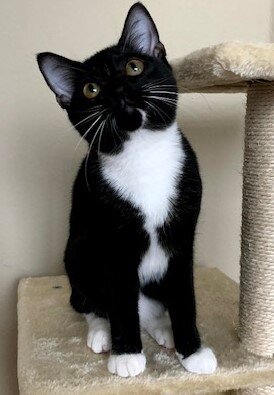Bringing home a new pet, whether it is a foster or a permanent addition to your family, can be very exciting! However, it is important to keep in mind that many of our animals have been recently surrendered or pulled from community shelters, so they may be experiencing an abnormal amount of stress and anxiety. It is important to identify a low-traffic and stress-free area of your house (possibly a small area like a bathroom) where your new foster can relax and get accustomed to new smells and sounds. Equip the immediate area, or room, with food, water, and a litter box.
One reason we recommend a small room is because cats will typically hide in new environments. It is not uncommon for a foster cat to hide underneath a bed or in a dark, quiet place for the first couple of days. Isolating your foster cat temporarily when you first bring them home allows you to know exactly where it is and helps you monitor its eating, drinking, and litter-box habits more closely.
A foster kitten, or litter of kittens, will need a space that is isolated from the people and other animals in your home. This is because the majority of kittens originate in either outdoor environments or shelter/pound environments – both of which can carry contagious bacteria and viruses. Since a kitten’s immunity is still developing it is very susceptible to nasty infections from other animals and it becomes a tiny adorable transport system for these contagions. It is best to keep it separate from other animals, and children, until the kitten has had its first FVRCP vaccination or reached an age/weight at which illness is unlikely.
Food & Litter
Cat food and litter are sometimes provided to DPR through community donations and other non-profit resources. When available, Desert Paws will fairly distribute any donated resources among its approved foster families. It will be your responsibility to provide adequate food and litter for your foster animal to keep it healthy and adoptable.
If you purchase food for your foster cat, we recommend Simply Nourish or Authority brands, both available only at PetSmart. Adopters receive special coupons for these brands, so it is a good idea to start off your foster cat eating the kind of food it will most likely eat after adoption. Purchases made for foster care (including mileage for transportation) are considered donations and are tax-deductible. Make sure you keep your receipts for reference during tax season!
Please let a DP Administrator know if you have any special needs or questions regarding the provision of food and litter for your foster animal.
Cat-proofing Your Home
Foster cats often come from an outside or shelter environment, and even if they have previously lived in a home, we don’t always know how they will react in a new home. So, before bringing home a new foster cat, you’ll want to survey the area where you are going to keep the cat. Remove anything that would be unsafe or undesirable for the cat to chew on, and securely latch any cupboards the foster cat could get into. Cats like to climb up on shelves or bookcases, so you’ll want to remove anything that can be knocked down. People food and chemicals can be very harmful if consumed by cats, so please store them in a place that the foster cat cannot access.
Never underestimate your foster cat’s abilities. Here are some additional tips for cat-proofing your home:
Make sure all trash cans are covered or latched or keep them inside a closet. (Don’t forget the bathroom trash bins.)
Keep toilet lids closed.
Keep both people and pet food out of reach and off countertops.
Move houseplants out of reach, many house plants are toxic to cats and they like to chew on them.
Make sure aquariums or cages that house small animals, like fish or hamsters, are securely out of reach of your foster cat.
Remove medications, lotions, or cosmetics from accessible surfaces.
Move and secure all electrical and phone wires out of reach, cats may chew on or get tangled in them.
Move and secure any hanging window blind cords that cats may damage or get tangled in.
Pick up any clothing items that have buttons or strings which can be harmful to your foster cat if consumed. Random pieces of yarn, thread, or ribbon can also be very dangerous to your foster if eaten.
Relocate fragile knickknacks or valuables that your foster cat could knockdown.
Introductions,
to family members, both two- and four-legged, should be stress-free. When meeting new people, it is best to let the cat approach on its own terms. When the cat approaches, provide gentle petting. If the cat shies away, be patient – do not force the cat to come to you. Holding them down to force affection, or chasing them, can scare a nervous cat and result in negative behaviors.
While foster cats playing with other pets is often fine, we advise that you consult with your veterinarian to ensure that all of your personal pets are healthy and up-to-date on all vaccines. Cats from pounds/shelters/outdoor environments can be very susceptible to illness and can carry or catch different diseases. If, for any reason, your personal pet becomes ill while you are fostering a Desert Paws cat, we cannot provide medical care for your personal pet.
Once you have determined that your foster cat is healthy and would like to introduce it to your resident cat(s), ensure that it is a gradual and stress-free experience. Bringing your foster cat home and letting it immediately roam free may cause a lot of unnecessary stress for both your resident cat(s) and your foster cat. Do not automatically expect your personal animals and your foster animal(s) to become fast friends – sometimes the best that you can hope for is for them to simply tolerate each other for the time being.
If you are introducing your foster cat to a resident dog, keep your dog on a leash when you bring your foster cat into your house for the first time. This will prevent any unpredictable behaviors, like chasing. Allow your foster cat to approach your dog on its own terms. Once the dog and cat become comfortable around each other, the leash will no longer be necessary. It is also a good idea to set up escape options and hiding spots throughout the house for your foster cat. Examples include a pet gate that will allow the cat over or through, but not the dog(s); vertical escapes like cat towers; or a small crate/area where the cat can hide and feel safe.
Since we don’t always know a foster cat’s history or tolerance level for different types of people and activities, please teach your children how to act responsibly and respectfully around your foster cat. We will do our best to place you with an appropriate animal for your home situation, but you should still supervise all interactions between children and your foster cat. Key things to remind your children:
Always leave the foster cat alone when he/she is eating or sleeping. Some cats may nip or bite if bothered while eating or startled while sleeping.
Do not tease or agitate the foster cat.
Don’t chase the foster cat around the house; it may scare them.
Pick up the foster cat only when an adult is there to help. Cats can become scared when picked up, and they sometimes scratch with their sharp nails, even though they don’t mean to cause harm.
Please also remind your children to be careful when opening and closing doors so as to not accidentally let the foster cat outside.
WHATS IN A NAME?
There are so many answers to this question but, most importantly, a cat or kitten’s name can contribute to the attention that they receive. If you are fostering a cat or kitten who does not already have a documented name, we may ask you get creative and come up with something!
We rely on adoption websites like PetFinder and Adopt a Pet to network our adoptable cats and kittens, which means that our adoptable animals are competing with thousands of other adoptables across the valley. Good photos certainly help with increasing profile views, but a good name can also help with making a great first impression!
DO!
First ask your Foster Coordinator or a DPR Board member if you can name or rename your foster cat or kittens!
Visit naming sites like PetPlace, BabyNames, or PetHelpful for ideas!
Consider using the same letter to begin each name (ex. Morty, Mike, & Mary). This helps DPR keep long-term track of a litter and keeps all of your kittens listed together on PetFinder/Adopt A Pet.
Consider an overall theme for the names (ex. Homer, Bart, & Maggie). This also helps DPR keep long-term track of who each kitten is and what litter they belonged to.
DON’T
Rename your foster cat or kittens without notifying the DPR Foster Coordinator or a DPR Board member.
Avoid names that have overwhelming negative connotations, like: Beast, Loki, Killer, or Troublemaker.
Avoid controversial political or religious figures or ideology.
Don’t be afraid to be unique! Keep away from common names like: Abby (Abbey, Abbi), Bella, Boomer, Cali (Callie), Calvin, Casper, Chloe, Cleo, Daisy, Eddie (Eddy, Edi), George (Georgie, Georgia), Grace (Gracie, Gracey), Harley, Indie (Indy), Jack (Jake, Jax), Jasper, Leo, Lily (Lilly), Lucy, Luna, Mittens, Marley, Max, Oliver (Olli, Olly, Ollie), Princess, Riley, Rome (Romeo), Rose (Rosey, Rosie), Roxie (Roxy), Salem, Sammy (Sammi, Sam), Sassy (Sassy, Sasi), Shadow, Socks (Sox), Tiger (Tigger), Willow.
How Do I Describe?
Fosters are often also asked to provide a description of their foster cat or kittens. These details are critical because this information gets registered to the cat’s microchip after they are adopted.
A Solid Black cat will be entirely black, with no other colors.
This is an example of a Black kitten With White.
Or you may see the variation of Grey w/White.
And this is an example of White With Black.
Or you may see the variation of White w/Grey.
But a black w/white pattern should not be confused with the classic Tuxedo.
A Tortoiseshell pattern can be any amount of black and orange, and can often contain browns and golds.
Or the variation of a Grey Tuxedo.
While a Calico pattern will have some amount of white.
A Dilute Tortoiseshell pattern will show as lighter colors like grey and beige.
And a Dilute Calico pattern displays the same variations with the addition of white.
Add tabby stripes to the mix and you have what is commonly identified as a Torbico (tabby+calico).
Brown Tabby
Grey or Silver Tabby
Black or Smoke Tabby
















